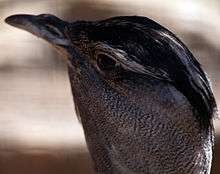Australian bustard
| Australian bustard | |
|---|---|
 | |
| Scientific classification | |
| Kingdom: | Animalia |
| Phylum: | Chordata |
| Class: | Aves |
| Order: | Otidiformes |
| Family: | Otididae |
| Genus: | Ardeotis |
| Species: | A. australia |
| Binomial name | |
| Ardeotis australis (Gray, 1829) | |
The Australian bustard (Ardeotis australis) is a large ground bird of grassland, woodland and open agricultural country across northern Australia and southern New Guinea. It is also commonly referred to as the plains turkey,[2] and in Central Australia as bush turkey,[3] particularly by Aboriginal people, though this name may also be used for the Australian brushturkey as well as the orange-footed scrubfowl.
Description
The male is up to 1.2 m (47 in) tall with a 2.3 m (7.5 ft) wingspan. The average weight for males is 6.3 kg (14 lb), with a range of 4.3 to 12.76 kg (9.5 to 28.1 lb).[4][5] The female is quite a bit smaller at 80 cm (31 in) tall, with a 1.8 m (5.9 ft) wingspan and an average body mass of 3.2 kg (7.1 lb) in a range of 2.4 to 6.35 kg (5.3 to 14.0 lb) but is similarly coloured.[4][5][6]
The largest male recorded was 14.5 kg (32 lb).[7] Although it is the largest extant flying land bird in Australia, this long-legged bird is the smallest species in the Ardeotis genus.[7] The back, wings and tail are dull brown, mottled black and white markings on the wing coverts. The neck and head appear dull white and the crown black. Legs are yellow to cream coloured.
When disturbed, Australian bustards often adopt a cryptic pose with neck erect and bill pointed skywards. They may stalk gradually away or run if alarmed, taking flight as a last resort. Populations are highly nomadic following rain and feed, which includes seeds, fruit, centipedes, insects, molluscs, lizards, young birds and small rodents.
Conservation status

This bird remains relatively common and widespread across most of northern Australia (see Atlas), but its range appears to have contracted in the south-east of the continent during the last century, perhaps due to hunting (now illegal except for indigenous Australians), feral predators such as pigs and foxes and habitat destruction. Its nomadic habits make it difficult to assess. In 2012 IUCN downlisted the species to Least Concern.[8]
The Australian bustard is not listed as threatened on the Environment Protection and Biodiversity Conservation Act 1999.
Victoria

- The Australian bustard is listed as threatened on the Victorian Flora and Fauna Guarantee Act 1988.[9] Under this Act, an Action Statement for the recovery and future management of this species has been prepared.[10]
- On the 2007 advisory list of threatened vertebrate fauna in Victoria, this species is listed as critically endangered.[11]
Aborigines and bush turkeys

Australian Aborigines generally refer to this bird as the bush turkey. It is an important food source for Aboriginal people from Central Australia, and is still being killed and eaten today despite its protected status. The white feathers of the bird are used for ceremonial purposes.
The Arrernte name for this bird is kere artewe. The Luritja name is kipara.[3] The Larrakia name for this bird is danimila.[12] There are important Dreaming stories associated with the bush turkey. A number of artists painting in the desert today paint bush turkey Dreaming. This means they have been given stories of the origins of the turkey in the Dreamtime and are entitled to tell this story and paint about it.[13][14]
Other
Barossa Valley winery Turkey Flat takes its name from the Australian bustard. 'Turkey Flat' was the local name given to Lot 1, 100 of Moorooroo (where the winery now sits) on settlement in reference to the large flocks of the Australian bustard found along the river banks. The winery's logo features an Australian bustard as drawn by renowned local artist, Rod Schubert.[15]
References
- ↑ BirdLife International (2012). "Ardeotis australis". IUCN Red List of Threatened Species. Version 2013.2. International Union for Conservation of Nature. Retrieved 26 November 2013.
- ↑ Tony Howard & Isobel Crawford. "The Australian Brush-Turkey In The Act: Further Discussion" (PDF). Canberra Bird Notes. pp. 173–176.
- 1 2 Bush Turkey. mjhall.org
- 1 2 Ziembicki, M (2010) Australian Bustard Archived April 6, 2012, at the Wayback Machine., CSIRO Publishing
- 1 2 CRC Handbook of Avian Body Masses by John B. Dunning Jr. (Editor). CRC Press (1992), ISBN 978-0-8493-4258-5.
- ↑ Australian Bustard – Ardeotis australis. Oiseaux.net (2009-10-25). Retrieved on 2012-08-21.
- 1 2 Wood, Gerald (1983). The Guinness Book of Animal Facts and Feats. ISBN 978-0-85112-235-9.
- ↑ "Recently recategorised species". Birdlife International (2012). Archived from the original on 28 August 2007. Retrieved 15 June 2012.
- ↑ Flora and Fauna Guarantee Act – Listed Taxa, Communities and Potentially Threatening Processes. Department of Sustainability and Environment, Victoria
- ↑ Flora and Fauna Guarantee Act: Index of Approved Action Statements. Department of Sustainability and Environment, Victoria
- ↑ Victorian Department of Sustainability and Environment (2007). Advisory List of Threatened Vertebrate Fauna in Victoria – 2007. East Melbourne, Victoria: Department of Sustainability and Environment. p. 15. ISBN 978-1-74208-039-0.
- ↑ Place Name, Lyons, NT, Australia. nt.gov.au
- ↑ Aboriginal Desert Art Gallery – ELIZABETH NAKAMARRA MARKS. aboriginal-desert-art.com.au
- ↑ Art Mob Magazine September 2005 Archived August 20, 2006, at the Wayback Machine.. artmob.com.au. Retrieved on 2012-08-21.
- ↑ http://www.turkeyflat.com.au/blog/our-history
- Frith, H (ed) Reader's Digest Complete Book of Australian Birds, 1977 ISBN 0-909486-50-6
- Simpson, K and Day, N,. Field Guide to the Birds of Australia 7th edition, 2004 ISBN 0-7136-6982-9
External links
| Wikimedia Commons has media related to Australian bustard. |
| Wikispecies has information related to: Ardeotis australis |
- NSW National Parks and Wildlife Service Threatened Species Information sheet (PDF accessed 27 July 2006)
